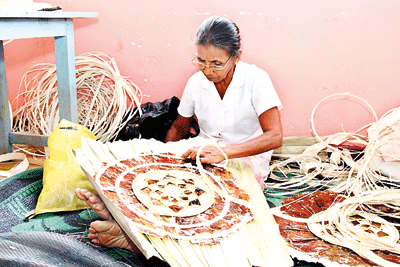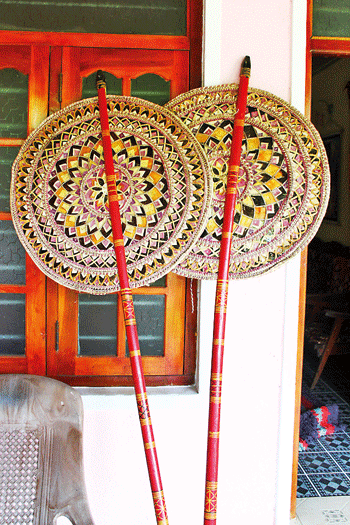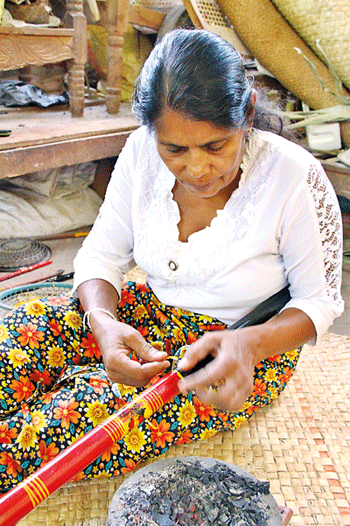Standing tall
 With the annual Esala Perahera now wending its way through the streets of Kandy, Sesath bearers are a prominent sight. Adding a regal air to this much looked forward to event in the cultural corpus of the country, sesaths have a colourful history. ‘Sesatha’ deriving its name from the Sanskrit term shveta-chatra or ‘white umbrella’ is believed to have served both a functional and ritual purpose of a sunshade for the aristocracy and as a symbol of grandeur and reverence at religious and other cultural observances.
With the annual Esala Perahera now wending its way through the streets of Kandy, Sesath bearers are a prominent sight. Adding a regal air to this much looked forward to event in the cultural corpus of the country, sesaths have a colourful history. ‘Sesatha’ deriving its name from the Sanskrit term shveta-chatra or ‘white umbrella’ is believed to have served both a functional and ritual purpose of a sunshade for the aristocracy and as a symbol of grandeur and reverence at religious and other cultural observances.
First making its appearance in the island as a shade for the Sri Maha Bodhi sapling brought here by Theri Sangamitta accompanied by a retinue of 500 bhikkunis and 18 artisans representing diverse crafts and industries, necessary to perform Sri Maha Bodhi-associated rituals, sesatha today is an item of home decor and an embellishment at ceremonial observances such as peraheras and at temples.
The story goes that as Thena Gurunnanse was burning the midnight oil in the rural hamlet of Unaveruwa off Matale, working on an intricate design of a sesatha, Loku Kiriya who had befriended the Gurunnanse would visit him at dusk and feign sleep while documenting in his mind, the well-guarded secrets of sesath-making. Although the knowledge is now in the public domain, the artisans of Unaveruwa take pride in the custodianship of this ancient form of art.

Side by side: A pair of completed Sesath. Pix by Indika Handuwala
The white-hued sesaths which were once a symbol of social standing and authority, particularly among the nobility are now largely obsolete, replaced with more colourful ones, transcending social status. Although the intricacy of the designs and their associated colours have seen winds of change, the raw materials involved are still the same. Thala leaves or talipot palm leaves (Coryphaumbraculifera)which become the base for the sesath designs, are sourced from the area by the Unaveruwa artistes.
Largely a female-labour intense craft today, this is a viable cottage industry for women in Unaveruwa to supplement the family income. The men contribute by sourcing thala leaves and Ginisapu- the type of timber used for the sesath-supporting poles. These poles (traditionally seven feet tall) are adorned with Laksha designs- another traditional form of art at the mercy of the few who still struggle to keep it alive.
Loku Kiriya not only changed the order of the art from a ‘hush-hush’ affair to an open cottage industry, and even set up a training centre in Unaveruwa in the 1960s to impart the skills to the next generation. There still remain old-timers who have apprenticed under him for a daily wage of one rupee!
Completion of a pair of sesath takes one to two weeks, depending on the design involved and the number of rings. “Although traditionally all sesaths were made to the 28-inch diameter requirement, today even smaller ones are in demand for various interior décor purposes,” explains D.B.G. Karunawathi whose husband is a descendant of the Thena Gurunnanse and his forefathers (Komala Durayalegedera clan) who are believed to have made Unaveruwa their home, having first arrived from India with the retinue of Theri Sangamitta.
The nelummala or the lotus which is a signature feature of the sesath has also given way to modernity, bemoans Karunawathi. “Ada ona patak daanawa” (today there is hardly any colour-consciousness) charges the veteran who cites white, red and yellow as the sesath-friendly tints. The natural dyes derived from boiled jak, patinga and madatiya are replaced with artificial dyes imported from India.
As G.G. Nandawathi, an award-winning sesath artist who steers Dimuthu Crafts Development Society of Unaveruwa, affiliated to the National Crafts Council explains, the sesath-making process begins with boiling of thala or talipot leaves for nearly three hours. A topping of Keppetitya and papaw leaves is added. The boiled thala leaves are sun-dried for about three to four days. The leaves are cut and transformed into multi-hued plaits and strips of palapethi and liyawel by the skilled Unaveruwa hands that later sew them into a pattern of concentric circles. Thin sheets of mica which support the pattern on leaves also add shimmer to the sesatha. The common grievance of all Unaveruwa folks is the sky rocketing price of mica supplied by middlemen. The fibre of the cocoa tree is also used to stitch various parts of a sesath together.

G.G.Nandawathi making a laksha design on a pole
More than a form of art which speaks of the dexterity of our craftsmen, sesatha is also a motif of social order, personified by the number of rings each entails. “The nine-ringed sesatha (mal-nawaya) is reserved exclusively for temples and Sangha. The seven-ringed sesatha in the olden days was meant only for the royalty and is often made for religious purposes today. The five-ringed sesath were for ministers of the royal court and aristocracy and three rings for the rest,” explains Nandawathi. Sesatha is also a symbol of prosperity, warding off the evil eye in traditional Sri Lankan weddings and becomes a mark of respect to the deceased at funerals, where the three-ringed sesatha is used.
Two sesaths are sewn together back to back to make one. Each completed sesatha has its twin, as customarily it is a pair which stands together. A good quality pair could last even for a century, provided they are unexposed to moisture, says Nandawathi.
Today the artistes are also recognised as a ‘craftsmen’ and issued an Identity Card by the National Crafts Council, receiving too easy payment home loans and other industry-related loans under the Samurdhi scheme. Although the new generation is no longer keen to be full-time craftsmen, even a ten-year-old from Unaveruwa knows the ropes of the trade, having grown up with the art. Kusuma Rajapaksha whose skill is passed down to her undergraduate daughter says, “Although she will not make this her full time vocation in future, the talent resides in her as in the case of all other young people from our village.”


